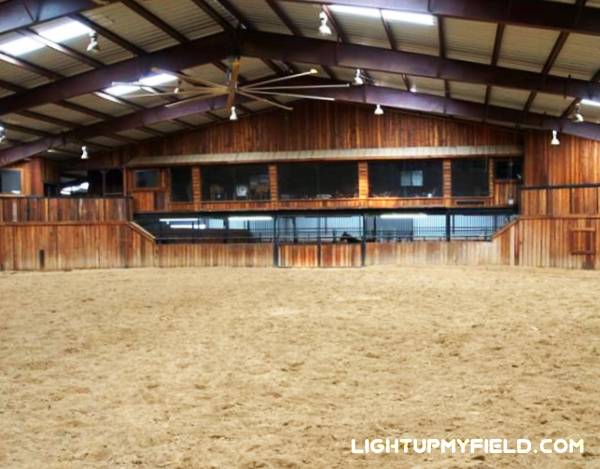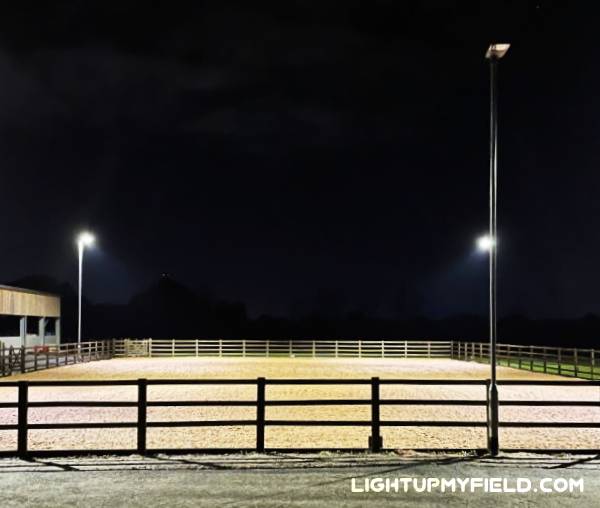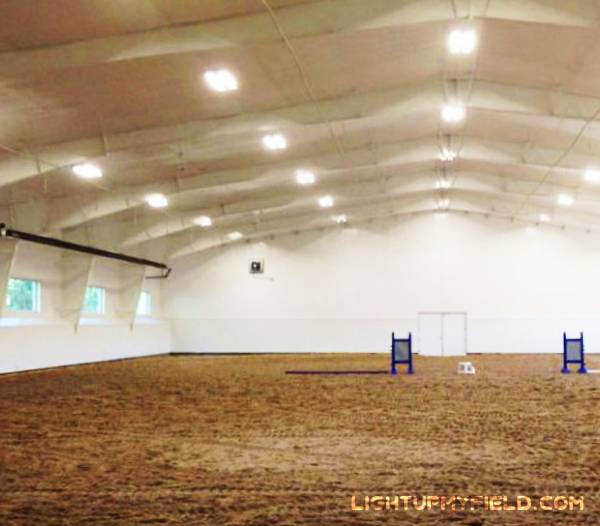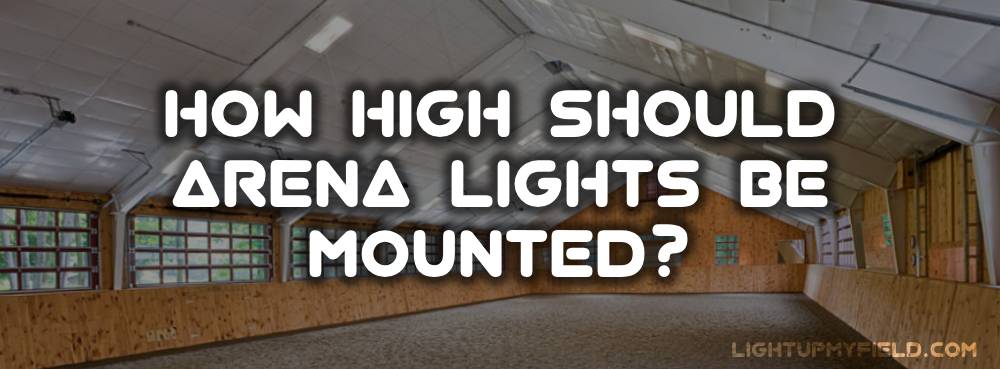Lighting is one of those things you don’t think much about until it’s wrong. In a horse arena, the wrong lighting height can mean blinding glare, distracting shadows, and uneven brightness — all of which make riding less comfortable and potentially unsafe. Mount the lights too low, and you’ll get intense hot spots and long, dark shadows. Mount them too high, and you might lose brightness on the ground or waste energy. So, how high should arena lights actually be mounted for the best results?
Table of Contents
ToggleWhy Mounting Height Matters More Than You Think

The height of your arena lights isn’t just about convenience or where you can fit a pole. It directly affects how evenly the light spreads, how much glare you get, and how safe the arena feels for both horses and riders.
When lights are mounted low — say at 3–4 meters (10–13 ft) — the beam has a shorter throw. That means the area right under the light is extremely bright, but just a few meters away, it’s noticeably dimmer. It also creates deep, sharp-edged shadows, which can make jumps look uneven or cause a horse to spook at footing changes that aren’t actually there.
On the other hand, if lights are mounted very high — for example, 12–15 meters (40–50 ft) in a small arena — the light spreads too widely before it reaches the ground. You lose intensity and may need much more powerful fixtures to achieve the same lux level. That’s more energy use and a higher electric bill for no real benefit.
There’s also the matter of uniformity, which is how consistent the brightness is across your arena surface. Poor mounting height often results in areas that are either glaringly bright or noticeably dim. Horses don’t adapt instantly to those changes in brightness, which can throw off their stride and confidence.
Recommended Mounting Heights for Different Arena Types
Outdoor Horse Arenas — Finding the Right Balance

When it comes to outdoor arenas, mounting height plays a huge role in how well your lights cover the space without making things awkward for horse and rider. Generally, you’ll want your lights mounted somewhere between 5 and 9 meters (about 16 to 30 feet) above the ground, but the exact height really depends on how big your arena is and what you’re using it for.
For smaller arenas — say, a 20 by 40 meter dressage or training pen — lights at around 5 to 6 meters (16–20 ft) do the job nicely. At this height, the light doesn’t lose too much intensity by the time it hits the footing, so you get solid brightness without needing mega-powerful fixtures. It also helps keep shadows from getting stretched out too long, which can confuse horses during precise movements.
Now, if you’ve got a bigger setup — like a 30 by 60 meter show jumping arena or a multipurpose outdoor ring — going a bit higher pays off. Mounting your lights around 7 to 9 meters (23–30 ft) gives the beams room to spread evenly across the whole area, preventing those annoying bright spots right under the lights and dark patches in between.
One bonus of higher mounting in outdoor arenas is how it reduces glare. The higher the fixture, the more indirect the light hitting riders’ eyes, which means less squinting and fewer distractions, especially during evening rides when the sun has dipped below the horizon. That soft, even light feels a lot easier on the eyes for everyone involved.
Another thing to keep in mind outdoors is shadow control. Outdoor arenas often have jumps, poles, barrels, and other obstacles, which can cast weird, distracting shadows if the lighting is too low. Mounting lights higher lets the beam angle get under and around these objects, cutting down those shadow bands that might otherwise spook a sensitive horse or make riders second-guess footing.
Indoor Riding Arenas — Working with the Space You’ve Got
 Indoor arenas are a bit trickier because you’re often limited by the ceiling height. The general guideline here is to mount your lights at least 4 to 6 meters (13 to 20 feet) above the footing, ideally as close as possible to the building’s highest point.
Indoor arenas are a bit trickier because you’re often limited by the ceiling height. The general guideline here is to mount your lights at least 4 to 6 meters (13 to 20 feet) above the footing, ideally as close as possible to the building’s highest point.
In smaller indoor spaces with low ceilings — some barns might only have 4 or 5 meters of clearance — you’ll want to be smart about your fixture choices. Selecting lights with wider beam angles helps compensate for the shorter throw distance. This way, you can still get even, soft coverage without intense bright spots or sharp shadows.
Mounting lights too low indoors can cause a bunch of issues. For one, the beams might bounce off walls, mirrors, or dust particles hanging in the air, creating a glare that’s downright distracting. This effect is usually worse in winter when condensation or dust buildup tends to be higher, turning your arena into a hazy, uncomfortable place.
If your arena is a standard size — say, 20 by 60 meters, which is common for dressage or schooling — mounting lights at about 6 meters (20 feet) often hits the sweet spot. At this height, you get good brightness across the whole surface without overwhelming the riders or horses with harsh light.
For larger indoor venues, like those hosting serious show jumping or competition-level events, you might want to push the mounting height even higher if the building structure allows it. Going closer to 7 or 8 meters (23–26 feet) can help you maintain higher lighting levels — often between 500 and 800 lux — which is what judges, riders, and camera crews generally look for during competitions.
When the ceiling height restricts how high you can go, sometimes you need to think about fixture spacing and beam angles even more carefully. Instead of relying on height to spread the light evenly, you might need more lights placed closer together, or lights with adjustable beams, to avoid those shadowy patches or glare hot spots.
| Arena Type | Arena Size (m) | Recommended Mounting Height (m) | Recommended Mounting Height (ft) |
|---|---|---|---|
| Outdoor Small Arena | ~20 × 40 | 5 – 6 | 16 – 20 |
| Outdoor Large Arena | 30 × 60 or bigger | 7 – 9 | 23 – 30 |
| Indoor Small Arena | ~20 × 40 | 4 – 6 | 13 – 20 |
| Indoor Standard Arena | ~20 × 60 | Around 6 | ~20 |
| Indoor Large/Competition | Larger than 20 × 60 | 7 – 8 | 23 – 26 |
How Can You Dodge Glare and Shadows in Arena Lighting?
Glare is one of those things that can totally mess with the vibe and performance in an arena. When lights are too bright or just not placed right, they end up being more of a pain than a help—causing discomfort for players and distractions for the crowd. Believe it or not, the height at which you mount your lights plays a huge role in keeping glare and shadows under control.
What Happens When Lights Are Mounted Too Low?
If the fixtures are hanging too close to the floor, say under 20 feet for an indoor court, players and officials might find themselves staring directly into bright bulbs. Imagine trying to track a fast-moving basketball or puck while having to squint against harsh light—that’s not fun. This kind of direct exposure can cause eye strain, headaches, and seriously mess with concentration.
Plus, mounting lights too low often results in uneven lighting across the playing surface. That’s because the light beams don’t have enough distance to spread evenly, creating harsh shadows in certain spots. Those shadows can confuse players, especially during quick movements or when following the ball, leading to mistakes or injuries.
What About Mounting Lights Too High?
You might think putting lights way up high—like 50 feet or more—would solve those issues, but it’s not that simple. When lights are mounted too far away, the brightness hitting the playing area drops off. The light spreads out too much, so it becomes weaker and can create dull or shadowy patches on the floor.
For example, an indoor basketball court lit by fixtures mounted 50 feet high might end up with an average illumination below the recommended 500 lux level, which is considered ideal for competitive play. To compensate, you’d need more lights or higher wattage bulbs, which means higher energy bills and more heat generated in the arena.
The Sweet Spot – Getting Height and Angles Right
Finding the right height is only part of the equation—you also need to angle the lights properly. By tilting fixtures just right, you can cover the playing surface evenly without having the beams shine straight into anyone’s eyes. For many indoor courts, mounting lights around 30 to 35 feet and angling them between 15 to 25 degrees off vertical tends to work well. This setup helps light the entire court smoothly while reducing glare for players and referees.
For outdoor fields, poles are usually taller—typically between 70 and 100 feet. At this height, the lights can spread their beams broadly to cover large areas without overwhelming players with direct light. Angling outdoor lights between 5 to 10 degrees from vertical often keeps the glare manageable, even under night sky conditions.
How to Get the Best Lighting Setup for Your Horse Arena
Start by Thinking About What You’ll Be Doing
Before you even pick out lights or decide on mounting heights, it helps to know what kind of riding you’ll mostly be doing in the arena. Different disciplines call for different levels of brightness.
For example, dressage training usually does well around 500 lux, which gives enough light to catch all those subtle cues and movements. But if you’re hosting show jumping competitions, especially at night, you might want to aim for closer to 900 or even 1,000 lux. That extra brightness helps riders and horses react faster and judge distances better.
Knowing your target brightness upfront shapes everything else — like how powerful your lights need to be and where they should go. Stronger fixtures can be mounted higher up without losing much light on the ground, while less powerful lights often need to be hung lower to keep the arena well lit.
Beam Angle and How It Affects Your Lighting
Another key factor to consider is the beam angle of your fixtures — basically, how wide or narrow the light spreads.
A narrow beam concentrates light in a smaller spot, which is great if you want the light to reach far across a big arena. But the downside is that it can cause uneven lighting, with super bright spots directly under the lights and darker patches in between.
Wider beam angles spread light out more evenly but lose intensity faster as the beam covers a larger area. The good news is, the higher you mount the lights, the better a narrow beam angle can spread across the arena.
For example, a light with an 80° beam mounted at 7 meters high will cover the arena more smoothly than the same light at 4 meters. If you’ve ever seen an arena with those bright “hot spots” right under each fixture and darker stripes along the footing, that’s usually a sign that either the beam angle is too narrow or the lights are mounted too low.
Getting the right combo of beam angle and mounting height helps avoid those annoying light-and-dark patches and keeps the footing evenly lit, which is way easier on both horse and rider.
Making Sure Your Light is Evenly Spread
Mounting height and fixture spacing go hand-in-hand. If you space your lights too far apart, you’ll end up with uneven coverage — some areas bright, others dim. But putting them too close wastes energy and might even create glare that’s uncomfortable to ride in.
Aiming for a uniformity ratio around 0.6 to 0.7 is a solid rule of thumb. This means the darkest part of your arena should be at least 60 to 70 percent as bright as the brightest spot. When you hit this balance, the arena feels consistent, and horses aren’t startled by sudden shadows or glaring lights.
Practically, this means positioning the fixtures so their beams slightly overlap, leaving no dark “dead zones” between them.
If you’re working with an indoor arena, the placement gets even trickier. Instead of mounting lights directly overhead, it’s better to put them along the sides — especially if your arena has a roof. This prevents the lights from shining straight into riders’ eyes when they look down the length of the arena, which can be really distracting or even dangerous during fast movements.
Pulling It All Together
Mounting height isn’t just a technical detail — it’s the foundation of how your arena will actually look and feel under lights. The right height creates a comfortable, shadow-free space where horses can see the footing clearly and riders can focus without squinting. Whether you’re lighting a small indoor schooling ring or a full-size outdoor competition arena, the sweet spot usually comes from balancing fixture power, beam angle, and height so the light is even and glare-free.
A well-planned setup means you can walk into your arena at night and ride with the same confidence you’d have at midday. Once you experience lighting that’s been mounted at just the right height, you’ll wonder how you ever put up with anything less.

